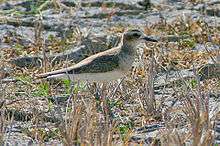Oriental plover
The oriental plover (Charadrius veredus) also known as the oriental dotterel, is a medium-sized Charadriine plover closely related to the Caspian plover. It breeds in parts of Mongolia and China, migrating southwards each year to spend its non-breeding season in Indonesia, New Guinea and northern Australia.
| Oriental plover | |
|---|---|
 | |
| Scientific classification | |
| Kingdom: | Animalia |
| Phylum: | Chordata |
| Class: | Aves |
| Order: | Charadriiformes |
| Family: | Charadriidae |
| Genus: | Charadrius |
| Species: | C. veredus |
| Binomial name | |
| Charadrius veredus Gould, 1848 | |
Description
Adult male in breeding plumage: white face, throat and fore-crown; grey-brown hind-crown, hind-neck and back; belly white, demarcated with narrow black band and then broad chestnut breast band merging into white throat. Female, juvenile and non-breeding male: generally grey-brown upperparts and white belly; pale face with white streak above eye. Measurements: length 21–25 cm; wingspan 46–53 cm; weight 95 g. Among the redbreasted Charadrius plovers, this bird is relatively large, longlegged and long-winged.
Distribution and habitat
Breeds in Mongolia, eastern Russia and Manchuria; migrates through eastern China and South-East Asia to Indonesia and northern Australia. Rare in New Guinea; straggler to New Zealand and Europe three times (Finland, Norway and Sweden). The oriental plover breeds in dry steppes, deserts, arid grasslands and saltpans. Its non-breeding habitat includes grasslands, salt-fields and coastal areas.[1]
Food
The oriental plover feeds mainly on insects.
Breeding
The breeding of this bird has not been much studied but it nests on the ground.
Conservation
About 90% of the oriental plovers that make the long journey south overwinter in Australia and it has been estimated that there may be 160,000 individuals of this species. With a large range and no evidence of significant population decline, this species’ conservation status is rated by the IUCN as being of Least Concern.[2]
References
- BirdLife International (2012). "Charadrius veredus". IUCN Red List of Threatened Species. 2012. Retrieved 26 November 2013.CS1 maint: ref=harv (link)
- "Species factsheet: Charadrius veredus". BirdLife International. Retrieved 2013-12-16.
- Marchant, S.; Higgins, P.J.; & Davies, J.N. (eds). (1994). Handbook of Australian, New Zealand and Antarctic Birds. Volume 2: Raptors to Lapwings. Oxford University Press: Melbourne. ISBN 0-19-553069-1
 Oriental Plover
Oriental Plover - National Photographic Index of Australian Wildlife. (1987). The Shorebirds of Australia. Angus & Robertson: Sydney. ISBN 0-207-15348-5
| Wikispecies has information related to Charadrius veredus |
